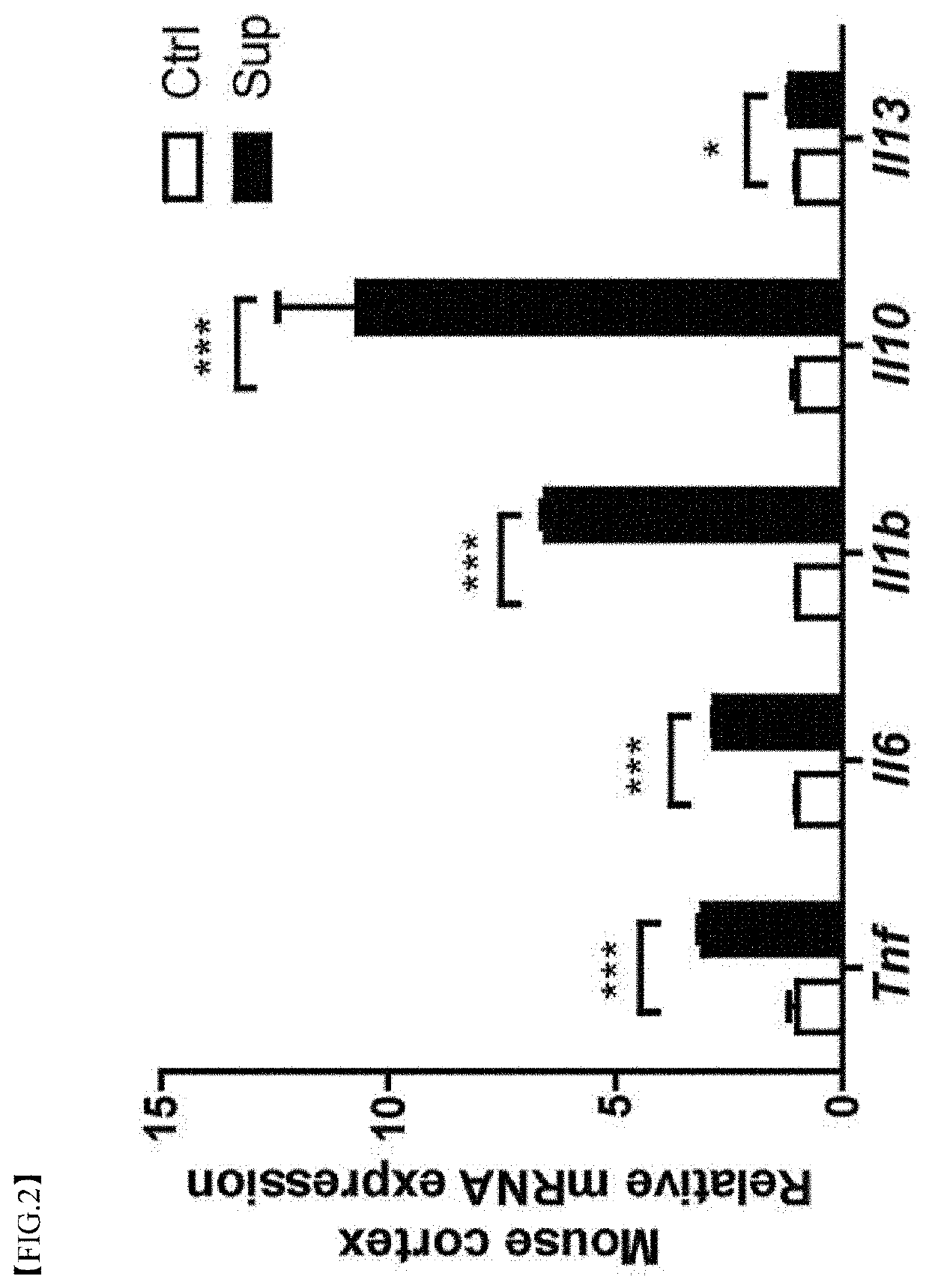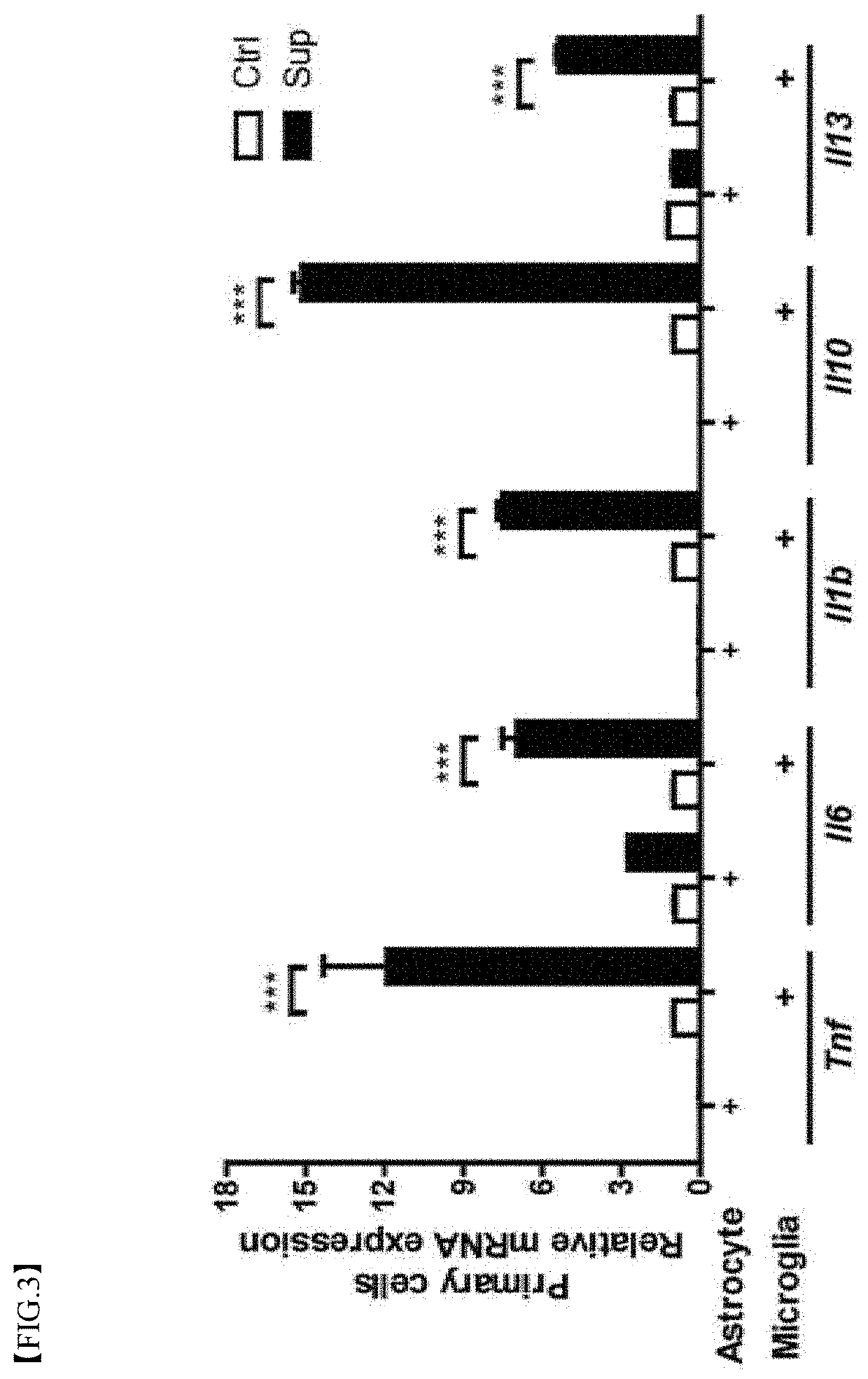Olfactory receptor as microglia marker and use thereof
- Summary
- Abstract
- Description
- Claims
- Application Information
AI Technical Summary
Benefits of technology
Problems solved by technology
Method used
Image
Examples
experiment preparation
REFERENCE. EXPERIMENTAL MATERIALS AND EXPERIMENT PREPARATION
[0118]1. Culture of Microglia and Astrocytes
[0119]In this example, microglia or astrocytes were primarily extracted from the cerebral cortex of E18.5 mouse embryos (Tamashiro et al., 2012), and cultured as described in Example 1. More specifically, the mouse embryonic cortex was collected, stored in a cold supernatant (#14170-112; Thermo Fisher Scientific), and pretreated in a 0.25% trypsin solution (#15090-046; Thermo Fisher Scientific) at 37° C. for 20 minutes. Afterward, cells were plated in a minimum nutrient medium supplemented with 10% FBS (#SH30919.03; Hyclone), 2 mM L-glutamine (#25030-081; Thermo Fisher Scientific), 0.04% glucose (#G7021; Sigma Aldrich), and 1% penicillin / streptomycin (#15140-122; Thermo Fisher Scientific), and filtered through a 40 pin strainer (#352340; Thermo Fisher Scientific). The microglia were plated at a density of 1.2×107 cells in a T75 flask coated with poly-D-lysine (#P7280; Sigma Aldric...
example 2
ion of Interaction Between 2-PF and Microglial Olfr110
[0183]The inventors hypothesized that metabolites released from S. pneumoniae can bind to OR and induce microglial activation. First, to determine an OR candidate, mRNA sequencing was performed on primary microglia. It was confirmed that, among 13 ORs (Olfr111, Olfr110, Olfr482, Olfr99, Olfr132, Olfr115, Olfr77, Olfr543, Olfr461, Olfr455, Olfr1420, Olfr1417 and Olfr57) found as described above, Olfr111 and Olfr110 are expressed at the highest levels (FIG. 11). Seven ORs (Olfr110, Olfr111, Olfr99, Olfr1029, Olfr433, Olfr222, and Olfr920) expressed in microglia were also found using a gene phenotype database (GSE52564; (Zhang et al., 2014). The seven ORs include Olfr111 and Olfr110, which are specifically expressed in microglia, compared to other cells. By integrating these processes, a total of 17 candidate receptors were yielded.
[0184]Many receptors recognizing pathogen-associated patterns are also induced by pathogen infection f...
example 3
ion of Microglial Activation by 2-PF
[0187]3.1. Confirmation of Microglial Activation by 2-PF
[0188]Next, it was investigated whether 2-PF is present in Sup using liquid-chromatography-tandem mass spectrometry (LC-MS / MS). After data on 2-PF was obtained using liquid-chromatography-tandem mass spectrometry (LC-MS / MS), a 2-PF ion precursor was identified using a mass-to-charge ratio (m / z=153.091). As a result, precursor ions were confirmed in Sup, but not in a control (FIG. 20). The same MS spectrum was also observed in both synthetic 2-PF and Sup (FIG. 21). As a result of comparing the intensity of 2-PF precursor ions between treatment with F102 and treatment with F104, it was confirmed that the F104 treatment increases the intensity (56.0-fold) more than that of the F102 treatment (FIG. 22). This result shows that 2-PF is specifically present in Sup. In addition, to examine whether 2-PF induces microglial activation in Sup, 2-PF is treated at 100, 300 and 500 μM, and microglia were pr...
PUM
| Property | Measurement | Unit |
|---|---|---|
| pH | aaaaa | aaaaa |
| pH | aaaaa | aaaaa |
| time- | aaaaa | aaaaa |
Abstract
Description
Claims
Application Information
 Login to View More
Login to View More - R&D
- Intellectual Property
- Life Sciences
- Materials
- Tech Scout
- Unparalleled Data Quality
- Higher Quality Content
- 60% Fewer Hallucinations
Browse by: Latest US Patents, China's latest patents, Technical Efficacy Thesaurus, Application Domain, Technology Topic, Popular Technical Reports.
© 2025 PatSnap. All rights reserved.Legal|Privacy policy|Modern Slavery Act Transparency Statement|Sitemap|About US| Contact US: help@patsnap.com



